Notch Fatigue Life Research Based on Critical Distance Theory
Abstract
:1. Introduction
2. Critical Distance Theory
3. Notched Specimen Fatigue Life Test
3.1. Test Materials
3.2. Experimental Design
- Firstly, polish off the protective coating and impurities of the specimen with a grinding machine to make the specimen show a metallic luster;
- Dry grinding with water-grit sandpaper (grit range ~), firstly, 45° forward to the position of the strain gauges, until uniform light scratches appear on the surface of the test piece;
- Continue dry grinding perpendicular to the previous direction until all the light scratches in the forward 45° direction have been removed;
- Sand in a circular direction (diameter ) until all the scratches produced in the first two steps are ground off and the surface is uniform;
- Clean the debris. Use a clean lint-free cotton cloth dipped in alcohol to scrub the test piece until no contamination occurs after the cotton cloth is scrubbed.
3.3. Test Loading
4. Finite Element Analysis
4.1. Finite Element Model of Notched Specimen
4.2. Fatigue Life Prediction Model
5. Experimental Results Compared with Theory
6. Conclusions
- (1)
- The stress prediction value based on the point method at the cross-sectional cutout of steel box girders is 7~13% higher than that of the line method, and the fatigue life prediction value of the point method is basically more than 50% lower than that of the line method; the point method prediction value is more conservative than that of the line method.
- (2)
- The fatigue prediction model of steel box girder transverse bulkhead arc cutouts proposed in this paper has high accuracy, which is more precise compared with other methods currently used in engineering applications, and verifies the effectiveness and feasibility of the critical distance method. The fatigue life prediction results of the line method and the section model fatigue test results are basically about 10% error, the source of error is inferred to be related to the size effect, and the error will be further reduced if the volume method is used.
- (3)
- Whether using the point method or the line method, the calculated characteristic stress decreases with the increase in notch radius; the fatigue life increases with the increase in notch radius. When designing the curved notch of steel box girder cross-sections, the appropriate increase in notch radius is beneficial to the improvement of the fatigue life of the structure.
- (4)
- In this paper, the fatigue test specimens are all smooth curved notch specimens, and for the members containing initial defects, the calculation model for assessing fatigue life using critical distance theory needs further study.
Author Contributions
Funding
Conflicts of Interest
References
- Li, H.; Wu, G. Fatigue Evaluation of Steel Bridge Details Integrating Multi-Scale Dynamic Analysis of Coupled Train-Track-Bridge System and Fracture Mechanics. Appl. Sci. 2020, 10, 3261. [Google Scholar] [CrossRef]
- Zhang, Q.H.; Bu, Y.Z.; Li, Q. Progress of research on fatigue of orthotropic anisotropic steel bridge panels. China J. Highw. 2017, 30, 14–30. [Google Scholar]
- Zhu, Z.; Yuan, T.; Xiang, Z.; Huang, Y.; Zhou, Y.E.; Shao, X. Behavior and Fatigue Performance of Details in an Orthotropic Steel Bridge with UHPC-Deck Plate Composite System under In-Service Traffic Flows. J. Bridge Eng. 2017, 23, 04017142. [Google Scholar] [CrossRef]
- Liu, Y.; Chen, Z.; Zeng, J.; Li, C.; Peng, H.; Gao, Y. Study of Secondary Effects of Fatigue Cracks in Cross Partitions of Steel Plate Reinforced Steel Box Girders. Appl. Sci. 2022, 12, 7198. [Google Scholar] [CrossRef]
- Chen, Z.Y.; Li, C.X.; Ke, L.; Guo, L.C.; Song, G.B. Fatigue Crack Repair and Optimization of Cope Holes in Orthotropic Steel Decks. China J. Highw. 2021, 34, 301–312. [Google Scholar]
- Chen, Y.; Lv, P.; Li, D. Research on Fatigue Strength for Weld Structure Details of Deck with U-rib and Diaphragm in Orthotropic Steel Bridge Deck. Metals 2019, 9, 484. [Google Scholar] [CrossRef]
- Chen, Z.-Y.; Li, C.-X.; He, J.; Xin, H.-H. Retrofit Fatigue Cracked Diaphragm Cutouts Using Improved Geometry in Orthotropic Steel Decks. Appl. Sci. 2020, 10, 3983. [Google Scholar] [CrossRef]
- Sim, H.B.; Uang, C.M. Stress analyses and parametric study on full-scale fatigue tests of rib-to-deck welded joints in steel orthotropic decks. J. Bridge Eng. 2012, 17, 765–773. [Google Scholar] [CrossRef]
- Song, Y.S.; Ding, Y.L.; Wang, G.X.; Li, A.Q. Fatigue-life evaluation of a high-speed railway bridge with an orthotropic steel deck integrating multiple factors. J. Perform. Constr. Facil. 2016, 30, 04016036. [Google Scholar] [CrossRef]
- Zhu, Z.; Xiang, Z. Fatigue cracking investigation on diaphragm cutout in a self-anchored suspension bridge with orthotropic steel deck. Struct. Infrastruct. Eng. 2019, 15, 1279–1291. [Google Scholar] [CrossRef]
- Yokozeki, K.; Miki, C. Fatigue evaluation for longitudinal-to-transverse rib connection of orthotropic steel deck by using structural hot spot stress. Weld. World 2016, 60, 83–92. [Google Scholar] [CrossRef]
- Huang, H.; Huang, C.; Peng, Z.; Li, Y.; Yin, H. Fatigue Life Prediction of Fan Blade Using Nominal Stress Method and Cumulative Fatigue Damage Theory. Int. J. Turbo Jet-Engines 2020, 37, 135–139. [Google Scholar] [CrossRef]
- Duran, J.A.R.; da Costa, D.J.R. An Evaluation of the Nominal Stress Method for Life Prediction of Cylindrical Circumferential V-Notched Specimens Tested under Variable Amplitude Loading. Appl. Mech. Mater. 2016, 851, 310–316. [Google Scholar] [CrossRef]
- Wang, B.; Liu, L.; Liu, Y.; Jia, X.; Xu, X.; Miao, K.; Ji, J. Full-Scale Fatigue Test and Finite Element Analysis on External Inclined Strut Welded Joints of a Wide-Flanged Composite Box Girder Bridge. Materials 2023, 16, 3637. [Google Scholar] [CrossRef]
- Ecker, A.; Unterweger, H. Fatigue Design in Penstocks—Comparison of the Nominal Stress and Structural Stress Method for Common Details. ce/Papers 2021, 4, 1126–1134. [Google Scholar] [CrossRef]
- Dong, D.S.; Lu, C.Y.; Teng, Y.Y. A Fatigue Life Analysis Method Based on Nominal Stress Method and MSC.FATIGUE Software. Adv. Mater. Res. 2012, 468–471, 663–667. [Google Scholar] [CrossRef]
- EN 1993-2; Eurocode 3: Design of Steel Structures—Part 2: Steel Bridges. CEN: London, UK, 2006.
- AASHTO. AASHTO LRFD, Bridge Design Specifications; Wiley: Washington, DC, USA, 2017. [Google Scholar]
- Susmel, L.; Taylor, D.; Tovo, R. The Theory of Critical Distances and the estimation of notch fatigue limits: L, a0 and open notches. Int. Conf. Comput. Exp. Eng. Sci. 2007, 1, 81–86. [Google Scholar]
- Liu, X.; Zhang, Y.; Xie, S.; Zhang, Q.; Guo, H. Fatigue Failure Analysis of Express Freight Sliding Side Covered Wagon Based on the Rigid-Flexibility Model. Int. J. Struct. Integr. 2019, 12, 98–108. [Google Scholar] [CrossRef]
- Kebir, T.; Correia, J.; Benguediab, M.; Jesus, A.M.P.D. Numerical Study of Fatigue Damage under Random Loading Using Rainflow Cycle Counting. Int. J. Struct. Integr. 2020, 12, 149–162. [Google Scholar] [CrossRef]
- Babich, D.; Bastun, V.; Dorodnykh, T. Structural-Probabilistic Modeling of Fatigue Failure under Elastic-Plastic Deformation. Int. J. Struct. Integr. 2019, 10, 484–496. [Google Scholar] [CrossRef]
- He, J.-C.; Zhu, S.-P.; Liao, D.; Niu, X.-P. Probabilistic Fatigue Assessment of Notched Components under Size Effect Using Critical Distance Theory. Eng. Fract. Mech. 2020, 235, 107150. [Google Scholar] [CrossRef]
- Zhou, H.; Wen, J.; Wang, Z.; Zhang, Y.; Du, X. Fatigue crack initiation prediction of cope hole details in orthotropic steel deck using the theory of critical distances. Fatigue Fract. Eng. Mater. Struct. 2016, 39, 1051–1066. [Google Scholar] [CrossRef]
- Neuber, H. Theory of Notch Stresses: Principles for Exact Calculation of Strength with Reference to Structural Form and Material, 2nd ed.; Springer: Berlin/Heidelberg, Germany, 1958. [Google Scholar]
- Peterson, R.E. Notch sensitivity. In Metal Fatigue; McGraw Hill: New York, NY, USA, 1959; pp. 293–306. [Google Scholar]
- Kim, J.-K.; Kim, D.-S.; Takeda, N. Notched Strength and Fracture Criterion in Fabric Composite Plates Containing a Circular Hole. J. Compos. Mater. 1995, 29, 982–998. [Google Scholar] [CrossRef]
- Ye, W.-L.; Zhu, S.-P.; Niu, X.; He, J.-C.; Correia, J.A.F.O. Fatigue Life Prediction of Notched Components under Size Effect Using Critical Distance Theory. Theor. Appl. Fract. Mech. 2022, 121, 103519. [Google Scholar] [CrossRef]
- Taylor, D. The Theory of Critical Distances applied to multiscale toughening mechanisms. Eng. Fract. Mech. 2019, 209, 392–403. [Google Scholar] [CrossRef]
- Taylor, D. The Theory of Critical Distances: A New Perspective in Fracture Mechanics; Elsevier: Oxford, UK, 2007. [Google Scholar]
- Xin, H.; Veljkovic, M. Fatigue crack initiation prediction using phantom nodes-based extended finite element method for S355 and S690 steel grades. Eng. Fract. Mech. 2019, 214, 164–176. [Google Scholar] [CrossRef]
- Gupta, R.S.; Xin, H.; Veljkovic, M. Fatigue crack propagation simulation of orthotropic bridge deck based on extended finite element method. Procedia Struct. Integr. 2019, 22, 283–290. [Google Scholar] [CrossRef]
- Ma, Y.; Wang, G.; Guo, Z.; Wang, L.; Jiang, T.; Zhang, J. Critical region method-based fatigue life prediction of notched steel wires of long-span bridges. Constr. Build. Mater. 2019, 225, 601–610. [Google Scholar] [CrossRef]
- Ma, Y.; He, Y.; Wang, G.; Wang, L.; Zhang, J.; Lee, D. Corrosion fatigue crack growth prediction of bridge suspender wires using Bayesian gaussian process. Int. J. Fatigue 2023, 168, 107377. [Google Scholar] [CrossRef]
- Taylor, D. The theory of critical distances. Eng. Fract. Mech. 2008, 75, 1696–1705. [Google Scholar] [CrossRef]
- Taylor, D. The Theory of Critical Distances: A New Perspective in Fracture Mechanics; Elsevier: Oxford, UK, 2010. [Google Scholar]
- GB/T3075-2021; Metallic Materials Fatigue Testing Axial Force Controlled Method. State Administration for Market Regulation: Beijing, China; National Standardization Management Committee: Beijing, China, 2021.
- GB/T21526-2008; Structural Adhesives Guidelines for the Surface Preparation of Metals and Plastics Prior to Adhesive Bonding. State Administration for Market Regulation: Beijing, China; National Standardization Management Committee: Beijing, China, 2008.
- Liu, Y.P.; Chen, C.Y.; Li, J.B.; Li, G.Q. Study on fatigue crack extension behavior of 14MnNbq welded bridge steel. Eng. Mech. 2008, 25, 209–213. (In Chinese) [Google Scholar]

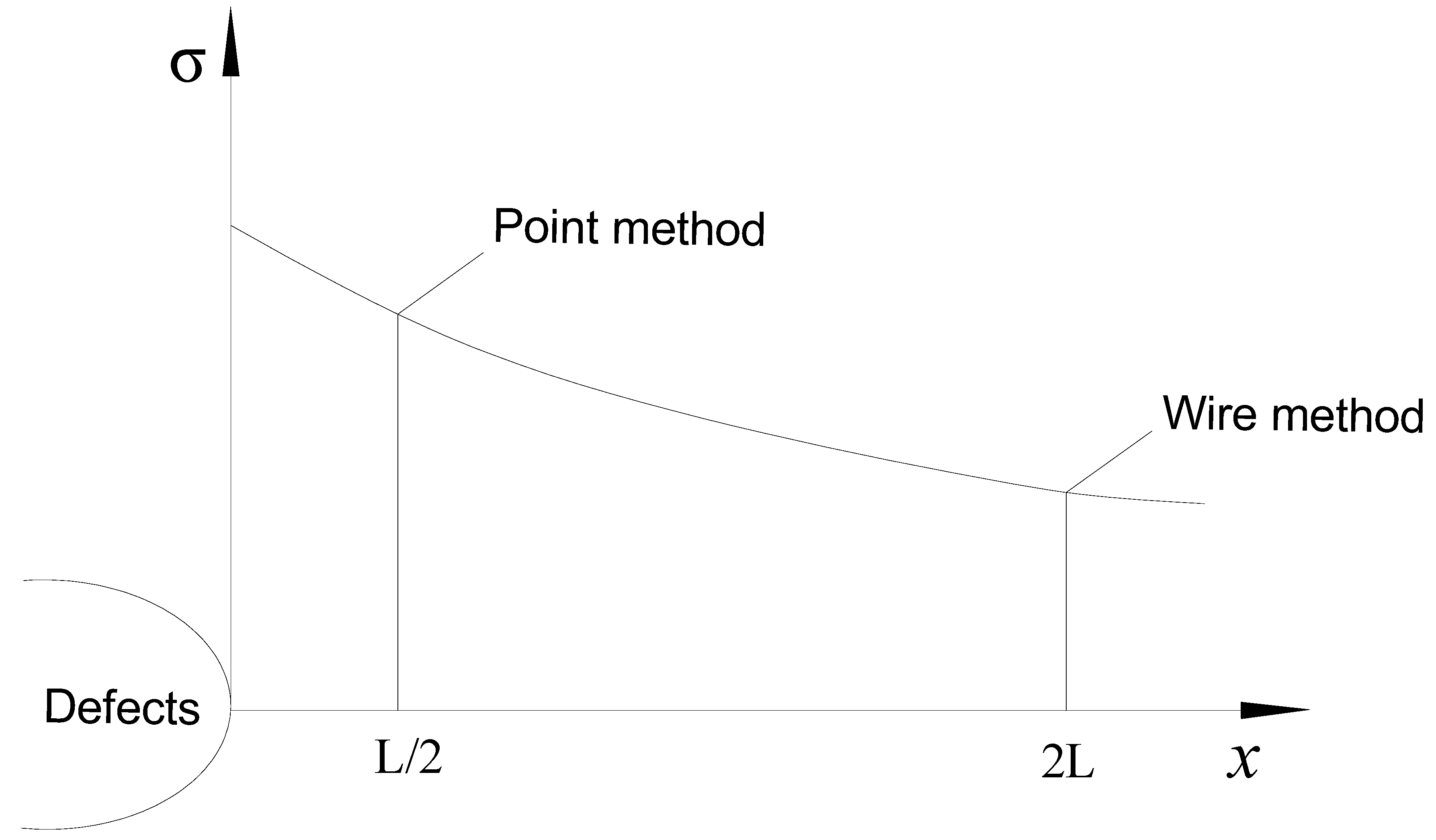
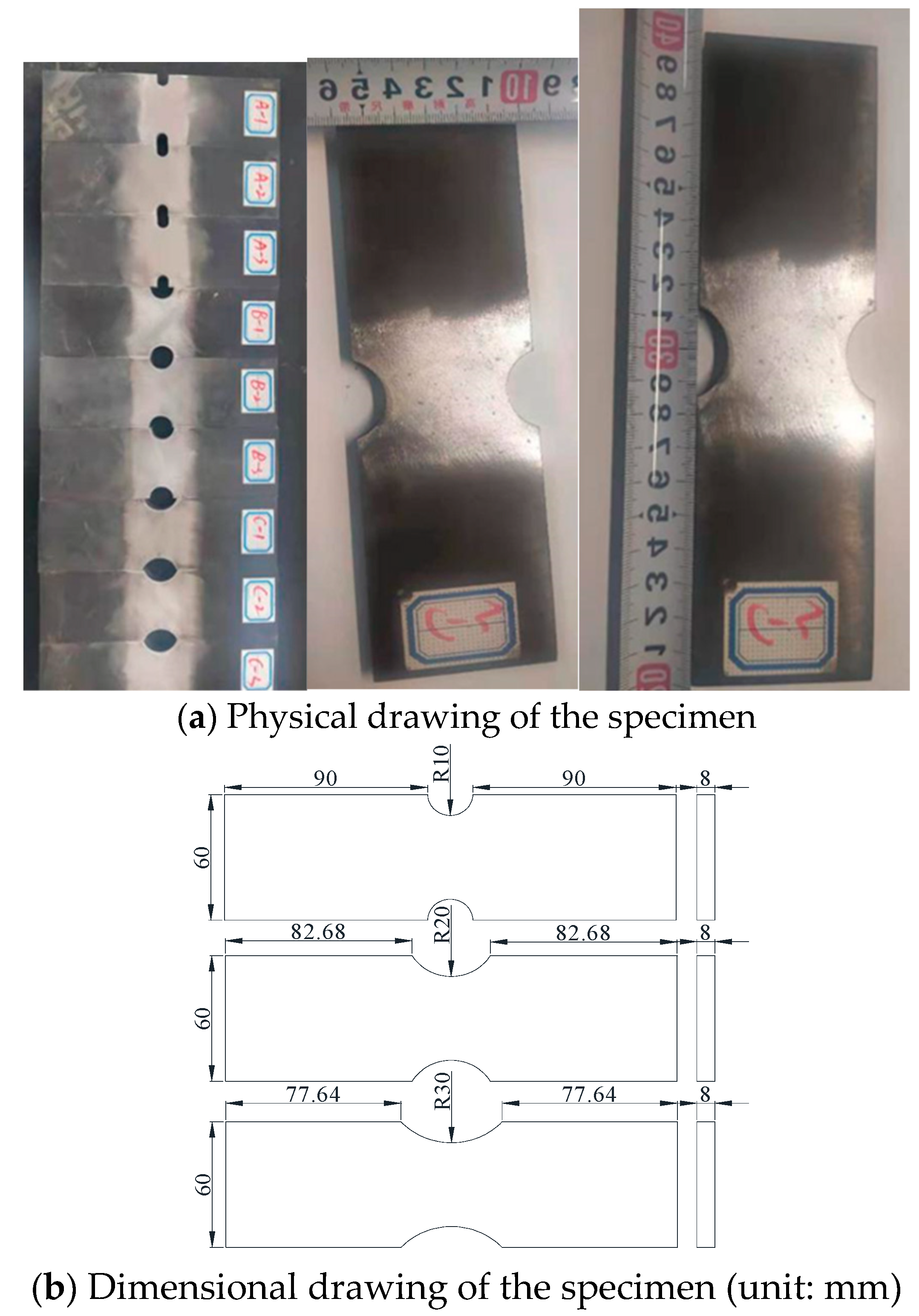

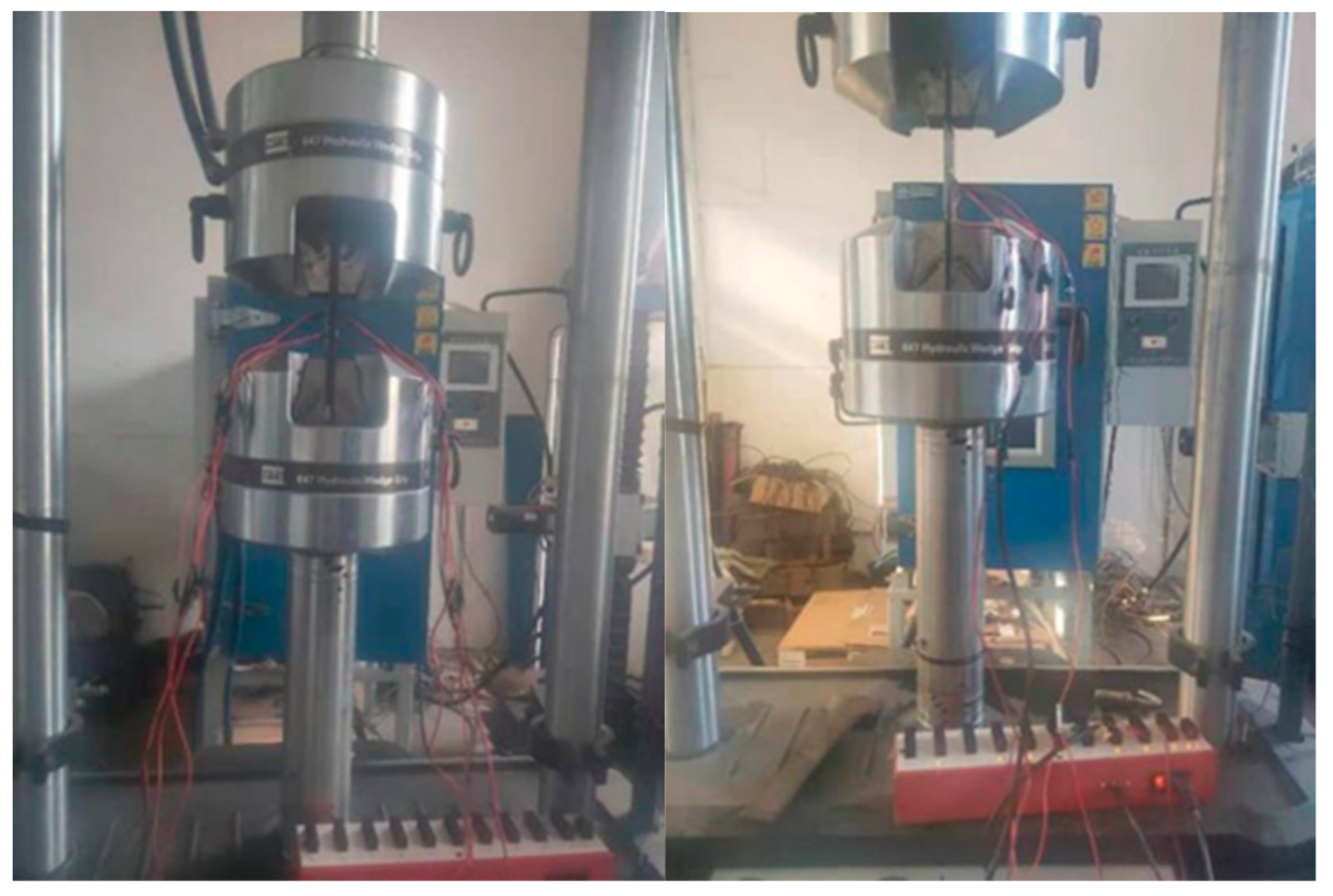

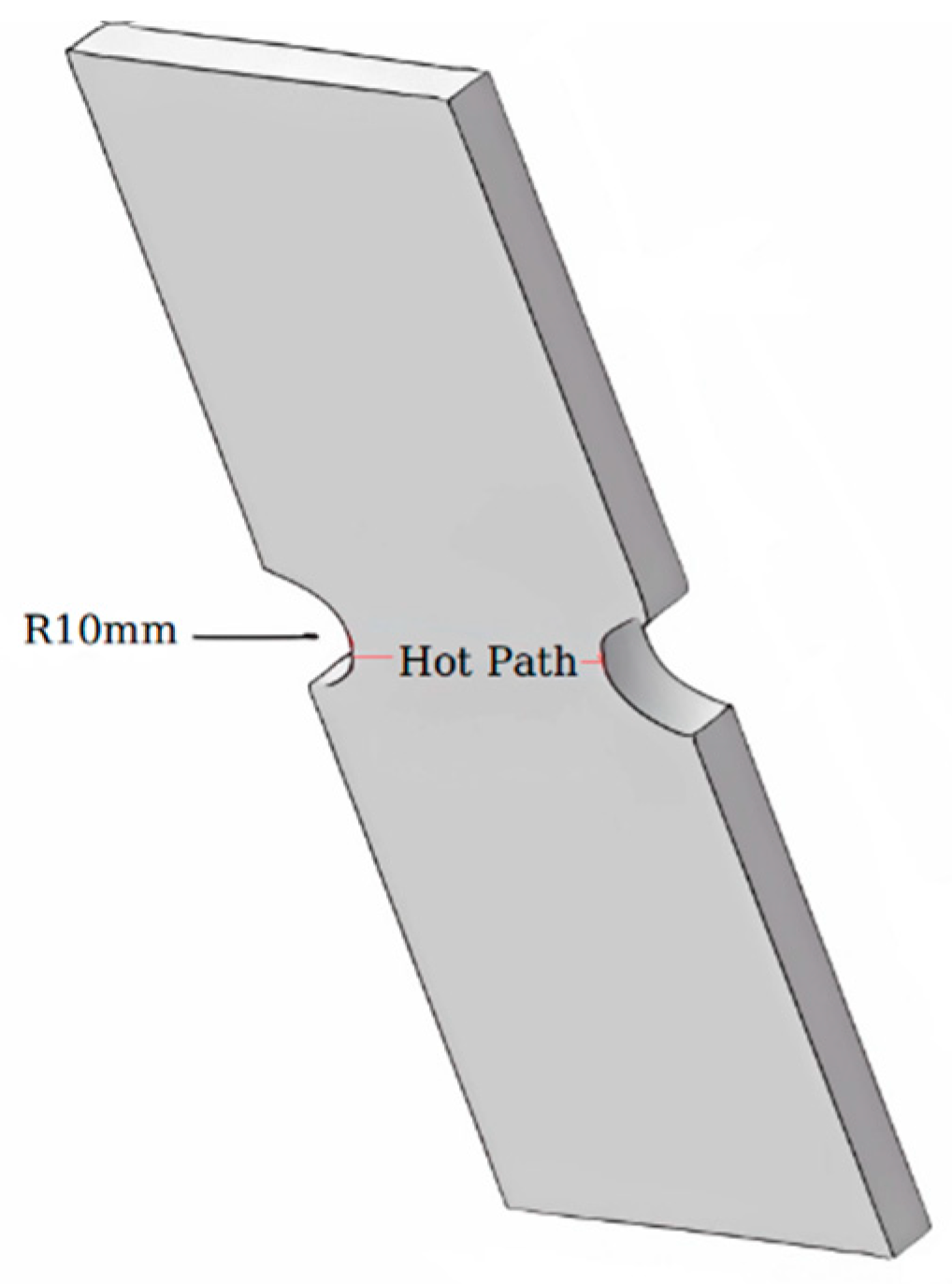
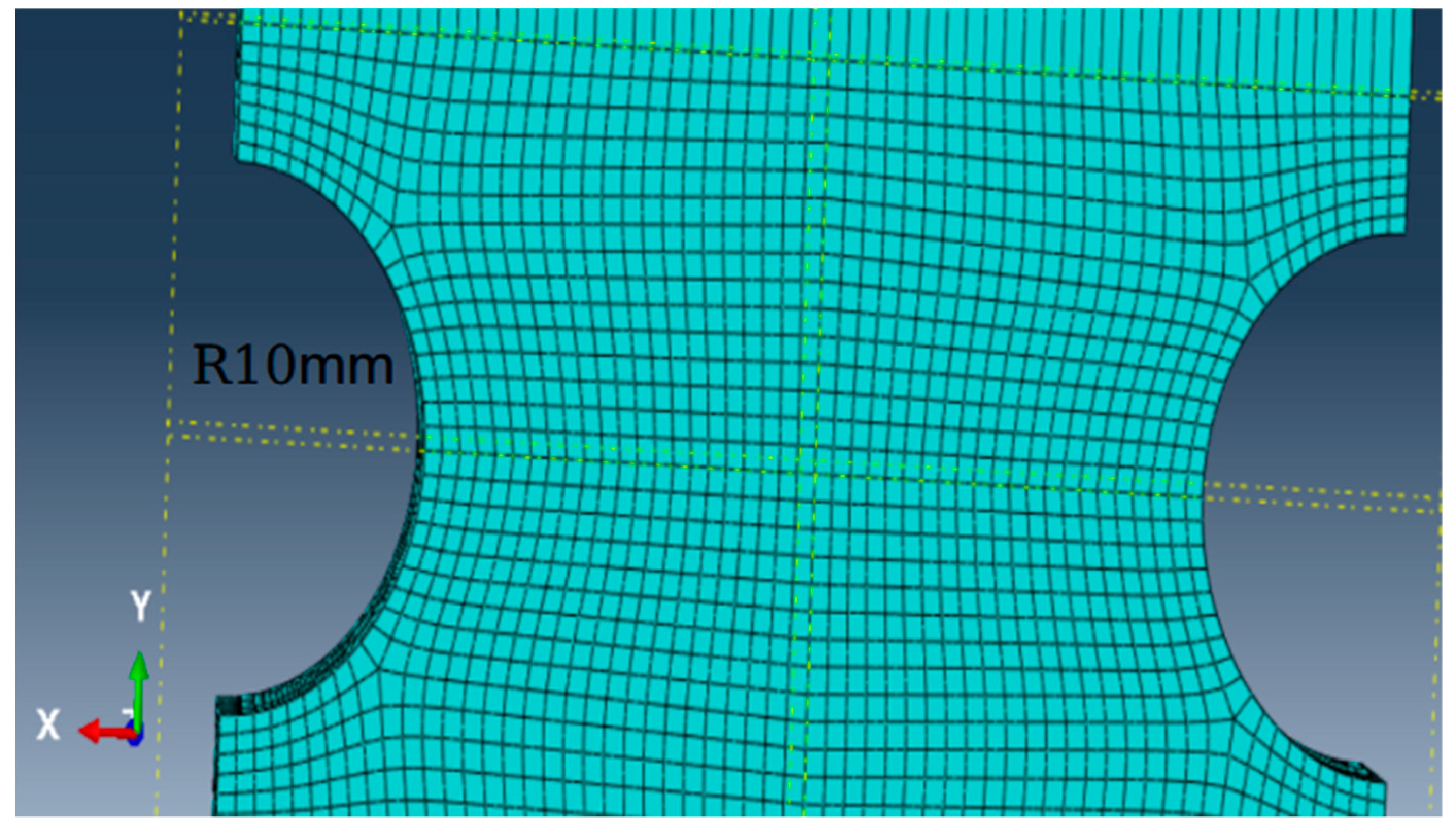

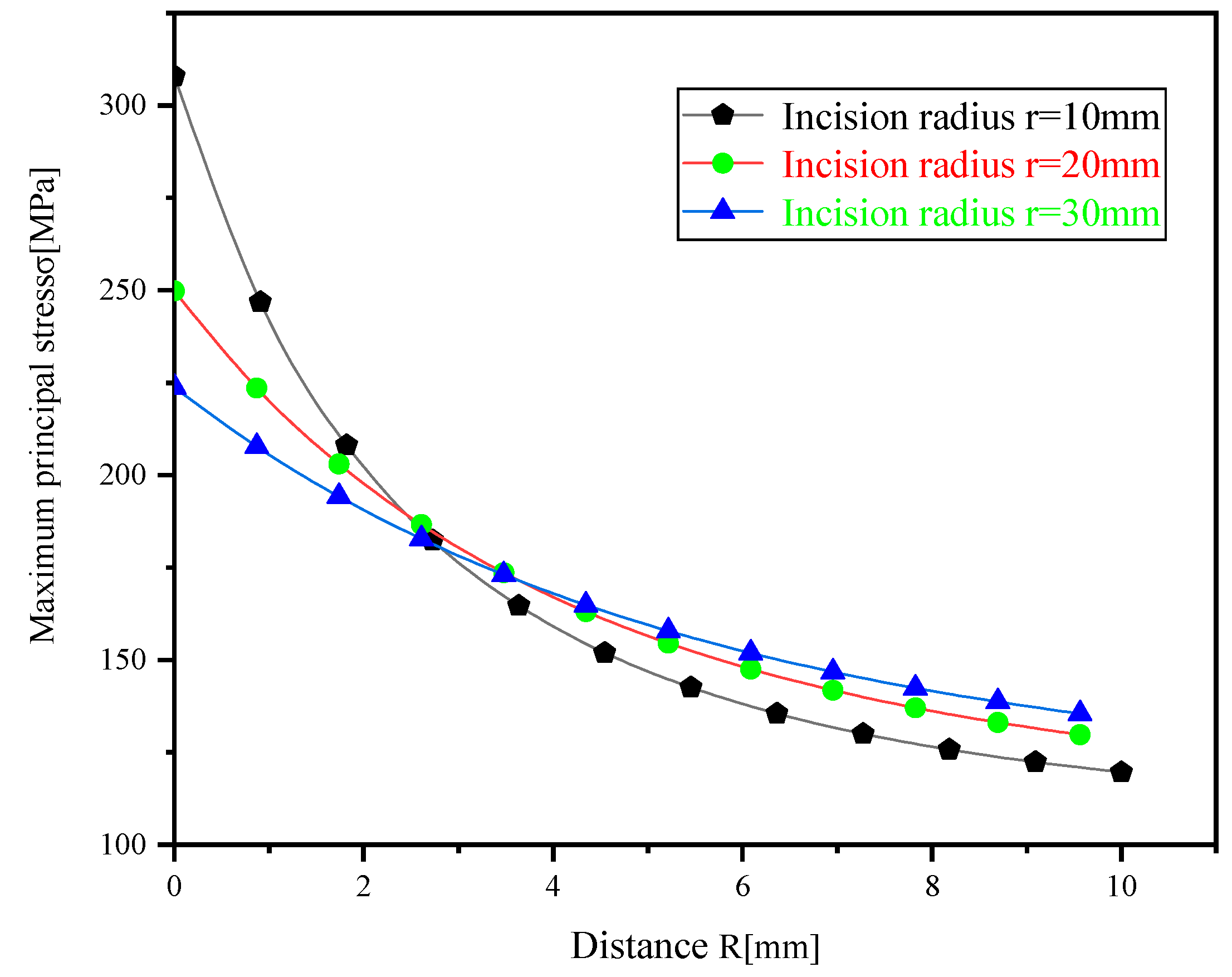

| Materials | ||||||||
|---|---|---|---|---|---|---|---|---|
| MPa | MPa | MPa | % | % | ||||
| Q345qd steel plate | 515.9 | 0.134 | 347.5 | 0.0015 | 204,153 | 30 | 72.54 | 0.3 |
| Axial Tensile Specimens | Specimen Thickness (mm) | Specimen Size (mm) | Notch Radius |
|---|---|---|---|
| A1–A3 | 10 | 200 × 60 | (R = 10 mm) |
| B1–B3 | 10 | 200 × 60 | (R = 20 mm) |
| C1–C3 | 10 | 200 × 60 | (R = 30 mm) |
| Notch Radius/mm | Fatigue Life/Cycles | Mean Value | ||
|---|---|---|---|---|
| 10 | 1,029,010 | 1,246,527 | 1,153,097 | 1,142,878 |
| 20 | 1,346,250 | 1,395,468 | 1,566,734 | 1,436,151 |
| 30 | 1,658,972 | 1,695,423 | 1,812,280 | 1,722,225 |
| Incision Radius/mm | Characteristic Stress/MPa | Fatigue Life/Number of Cycles | |
|---|---|---|---|
| Point Method | Line Method | ||
| 10 | 244.40 | 215.75 | 1,142,878 |
| 20 | 221.41 | 203.13 | 1,436,151 |
| 30 | 206.37 | 193.62 | 1,722,225 |
| Specimens | 1 | 2 | 3 | 4 |
|---|---|---|---|---|
| Point method characteristic stress (MPa) | 90.7 | 92.4 | 80.4 | 180.6 |
| Line method characteristic stress (MPa) | 85.2 | 88.8 | 74.6 | 171.9 |
| Actual life span () | 4.4 | 3.6 | 8.6 | 0.3 |
| Point method of predicting life expectancy () | 1.25 | 1.20 | 1.67 | 0.24 |
| Line method for predicting life expectancy () | 3.69 | 3.16 | 6.11 | 0.26 |
| Point method error value (/%) | 70.9 | 66.7 | 80.6 | 20.0 |
| Line method error value (/%) | 16.0 | 12.3 | 29.0 | 13.7 |
Disclaimer/Publisher’s Note: The statements, opinions and data contained in all publications are solely those of the individual author(s) and contributor(s) and not of MDPI and/or the editor(s). MDPI and/or the editor(s) disclaim responsibility for any injury to people or property resulting from any ideas, methods, instructions or products referred to in the content. |
© 2023 by the authors. Licensee MDPI, Basel, Switzerland. This article is an open access article distributed under the terms and conditions of the Creative Commons Attribution (CC BY) license (https://creativecommons.org/licenses/by/4.0/).
Share and Cite
Chen, J.; Ni, H.; Huang, L.; Yang, Y.; Chen, Z. Notch Fatigue Life Research Based on Critical Distance Theory. Appl. Sci. 2023, 13, 9641. https://doi.org/10.3390/app13179641
Chen J, Ni H, Huang L, Yang Y, Chen Z. Notch Fatigue Life Research Based on Critical Distance Theory. Applied Sciences. 2023; 13(17):9641. https://doi.org/10.3390/app13179641
Chicago/Turabian StyleChen, Jifa, Hao Ni, Li Huang, Yu Yang, and Zhuoyi Chen. 2023. "Notch Fatigue Life Research Based on Critical Distance Theory" Applied Sciences 13, no. 17: 9641. https://doi.org/10.3390/app13179641
APA StyleChen, J., Ni, H., Huang, L., Yang, Y., & Chen, Z. (2023). Notch Fatigue Life Research Based on Critical Distance Theory. Applied Sciences, 13(17), 9641. https://doi.org/10.3390/app13179641







